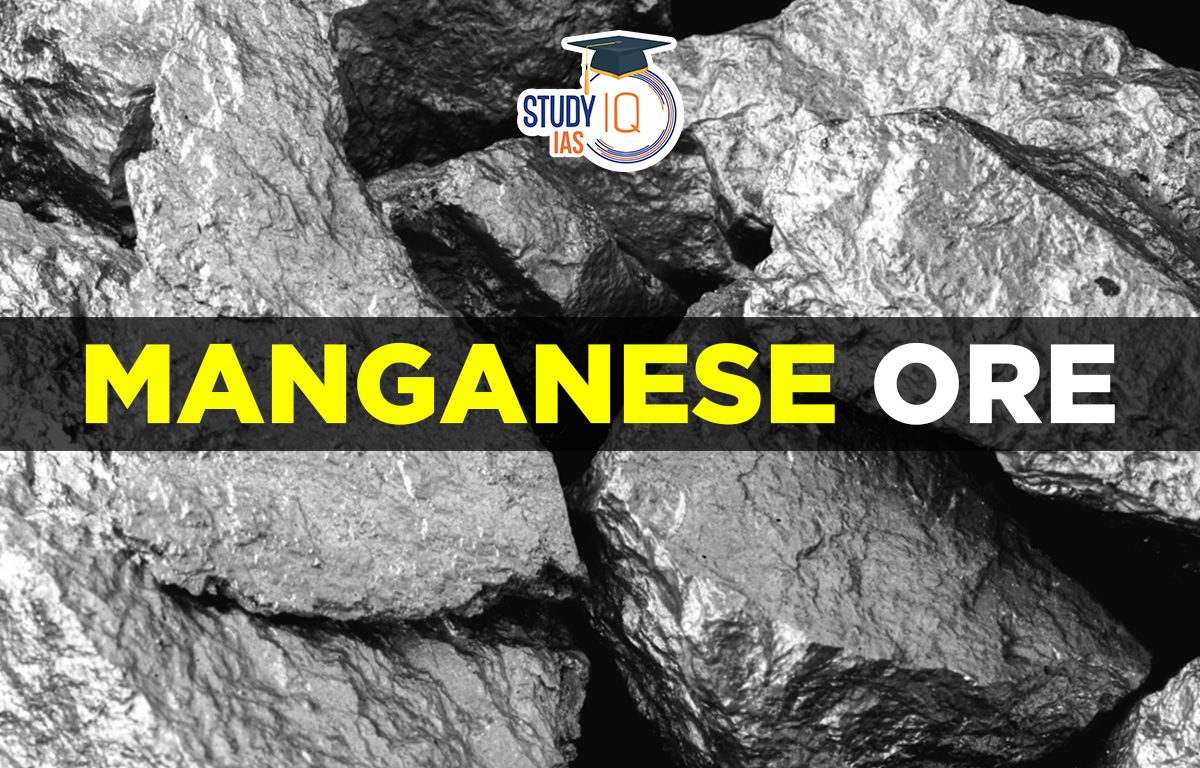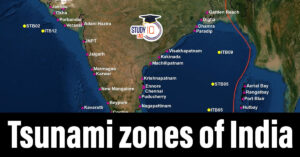Table of Contents
Recently, a team of scientists has claimed that Manganese (Mn) contamination of water is causing cancer in the Gangetic plains of Bihar.
About Manganese (Mn)
- Manganese is the fifth-most abundant metal on earth. It exists in the form of oxides, carbonates and silicates.
- Manganese is not found as a free element in nature. It is often found in combination with iron.
- The most important manganese ore is pyrolusite.
Properties
- Manganese is a silvery-gray metal that resembles iron. It is harder than iron but very brittle.
- It is chemically reactive and decomposes slowly in cold water.
- Manganese tarnishes slowly in air and oxidizes (rusts) like iron in water containing dissolved oxygen.
Biological Importance
- Helps in enzyme activation.
- Crucial for bone formation, metabolism of carbohydrates, amino acids and cholesterol. Also contributes to antioxidant defense systems.
Toxicity of Manganese
Small amounts are beneficial, excess manganese can be toxic.
Sources of Exposure
- Water: Groundwater with high Mn levels (natural or industrial pollution).
- Air: Industrial emissions from mining, welding and steel production.
- Soil and Food: Geogenic sources or contaminated irrigation water.
Health Effects
- Neurological: Chronic exposure can lead to Manganism, a condition similar to Parkinson’s disease.
- Cognitive Impairments: Memory loss, learning difficulties.
- Cancer Risk: Recent studies indicate prolonged Mn exposure may contribute to carcinogenesis (e.g., the Bihar study on water contamination).
| Facts |
|
Manganese Ore
Manganese (Mn) is a hard, brittle metal that is silvery white and belongs to Group 7 of the periodic table. Swedish scientist Carl Wilhelm Scheele discovered it while studying the mineral pyrolusite in 1774. Manganese is important for making steel, but it is not used on its own. Most manganese used in iron and steel production comes in the forms of ferro manganese and silico manganese alloys. In blast or electric furnaces, companies combine manganese ores with carbon to create ferro manganese, which is then used to make steel.
You can find manganese deposits in many types of rocks, but they are mostly linked to the Dharwar system. Odisha is the top producer of manganese in India. The main mines in Odisha are located in the central iron ore belt, especially in places like Bonai, Kendujhar, Sundergarh, Gangpur, Koraput, Kalahandi, and Bolangir.
Manganese Resources in India
India is a major producer of manganese, a vital industrial metal used in steelmaking, batteries, and other applications. Here’s an overview of manganese resources in India:
Reserves and Distribution
India has a lot of manganese, with around 432 million tonnes available as of 2022.
- Odisha has the most, making up 44% of the total.
- Karnataka comes next with 22%.
- Madhya Pradesh has 12%.
- Maharashtra and Goa each have 7%.
- Andhra Pradesh has 4%.
- Jharkhand has 2%.
Production and Major Producers
India is a big producer of manganese, making up about 5% of the world’s total. In 2021-22, the country produced 2.45 million tonnes of manganese ore. Madhya Pradesh is the top producer, followed by Maharashtra and Odisha. Some major mining companies are MOIL (Manganese Ore India Limited), Sandur Manganese & Iron Ores Ltd, and Tata Steel.
The districts with significant manganese resources in India are given below:
| State | Districts |
| Odisha |
|
| Madhya Pradesh |
|
| Maharashtra |
|
| Andhra Pradesh |
|
| Gujarat |
|
| Karnataka |
|
| Goa | Bicholim, Sanguem and Sataritalukas |
Manganese Ore Distribution in India
| State | Percentage of Production |
| Maharashtra |
|
| Andhra Pradesh |
|
| Madhya Pradesh |
|
| Odisha |
|
| Karnataka |
|
| Other Producers |
|
Manganese Ore Distribution in World
China is the largest manganese producer, followed by South Africa. Manganese is also widely distributed in India, Ghana, and Brazil.
| Country | Regions |
| China | Guangxi, Hunan, and Guizhou provinces. |
| South Africa | Postmasburg, Kuruman and west of Kimberly |
| CIS | Nikopol and Tokmak in Ukraine, Chiature in Georgia, Ulu Teljak in the Urals, Usa in Kuzbass. |
| India | Balaghat, Vishakhapatnam, Singhbhum, Goa |
| Ghana | Nsuta |
| Brazil | Near Mecapa in Amapa, Minas Gerais, Urucum in western Mato Grosso. |
| Others | Deposits as nodules, especially in the Pacific Ocean. |
Uses of Manganese Ore
Basic raw material for manufacturing steel alloys, used in the manufacturing of bleaching powder, insecticides, paints and batteries. Manganese ore is very useful in many industries because of its special properties. Here are the main uses:
- Steel Production: Manganese is mostly used in making steel. It helps make the steel stronger and tougher.
- Aluminum Production: Manganese is added to some aluminum mixes to make them stronger and resist rust.
- Batteries: Manganese dioxide is used in batteries, like alkaline and lithium-ion batteries, to improve their energy and performance.
- Chemical Industry: Manganese is used to make different chemicals, like potassium permanganate, which is a disinfectant for cleaning water.
- Fertilizers: Manganese helps plants grow, so it is added to fertilizers as manganese sulfate.
- Glass and Ceramics: Manganese is used to add colors to glass and ceramics, creating shades from pink to violet.
- Animal Feed: Manganese is added to animal feed to help livestock grow and stay healthy.
- Electronics: Manganese can be used in making electronic parts because it conducts electricity.
Manganese Ore Importance
Manganese ore is important for several reasons:
- Manganese is an extremely hard and brittle silvery grey mineral.
- It is always found with iron, laterite, and other minerals.
- Manganese alloys are an important component of steel production, and steel is one of the most important indicators of a country’s industrial economy’s growth.
- In recent years, the global trade volume of manganese ore has increased, including in India.
- India is currently one of the world’s largest manganese ore importers.
Manganese UPSC
India has a diverse range of mineral resources due to its diverse geological structure. India processes the world’s second-largest manganese reserves, after Zimbabwe. India is the world’s fifth-largest producer, trailing only China, Gabon, South Africa, and Australia. Maharashtra, Madhya Pradesh, Odisha, Andhra Pradesh, and Karnataka are the major manganese ore-producing states. Maharashtra and Madhya Pradesh produce more than half of India’s manganese. This article will explain Manganese Resources in India, which will help you prepare for the UPSC Civil Service Exam in Geography.
| Other Important Topics | |
| Wetlands in India | Types of Soils |
| Mountains of India | Types of Rocks |
| Land Reforms in India | Energy Resources |
| Cobalt Ore |
Aluminium Ore |


 Jallianwala Bagh Massacre, Date, History...
Jallianwala Bagh Massacre, Date, History...
 Vizhinjam International Seaport Project,...
Vizhinjam International Seaport Project,...
 Tsunami Zones of India, Causes and Subdu...
Tsunami Zones of India, Causes and Subdu...





















